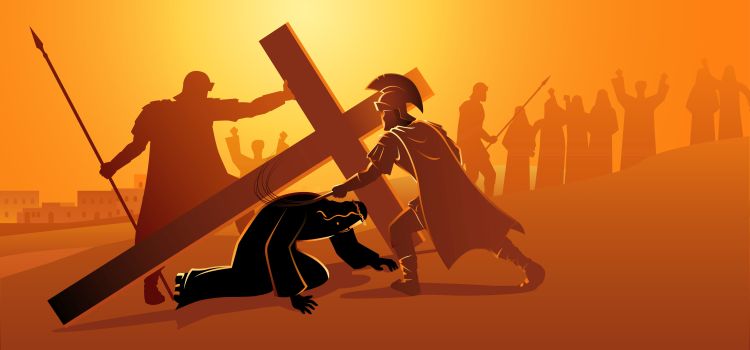
Hello everyone,
Welcome to the latest issue of our church newsletter. Our newsletter is sent out regularly to share reflections from services, Bible readings and church news to our church family. You can find previous issues on our church website here. We would love to hear from you and are always looking for uplifting and encouraging content to share in future issues of this newsletter. If you have any ideas or content that we can share, please do email them to Louise (publicity@christchurchuxbridge.org.uk)
Happy Easter to you all. The newsletter team will be taking a break next week. The next newsletter will be on 21 April.
Opening Prayer
Wonderful God,
thank you that you meet us
right here where we are sitting –
in the ordinary stuff and activities of this day.
As we journey through the Easter season
may we recognise you in Christ Jesus,
be empowered to live like him –
to live into the preciousness of the life
that you sustain in us.
Amen.
(Adapted from Roots)
Reflection from 2 April – What did He think He was doing?
Reading: Matthew 21: 1-11
We’re thinking about Jesus entering into Jerusalem. But what was he thinking? Was he mad? Was he intentional – and if so what were his intentions? So come with me, think about being in the crowd, beside the road . It’s dusty and hot. Smells abound – the food stand, the spring flowers. There’s a parade coming into town, huge commotion and noise and shouts, people rushing back and forth and you think what is this – are we safe? Should we run and hide? Then you see palm leaves flapping around, people dashing about – someone says they’re excited that the Son of David, the Messiah for the Jews, the promised on of old is coming and then you see a man riding on a donkey and there’s a sense of confusion.
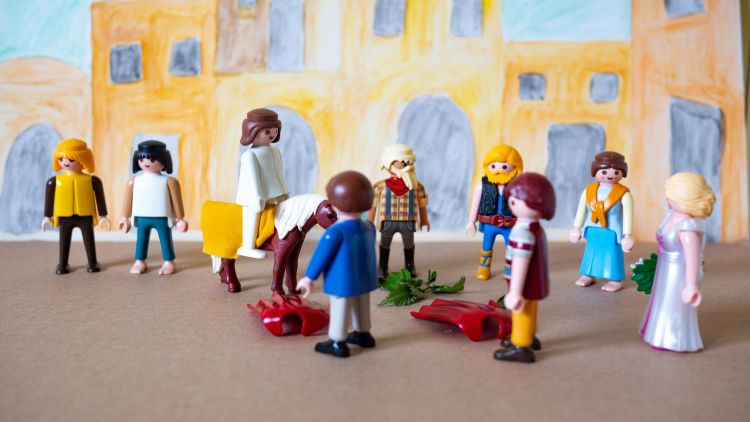
By the way, I did invite the young people to disrupt me earlier- I hoped it would lead to a sense of confusion – an experiential sermon if you will. As well as intentionally honour them and let them take centre stage in our church and in our service.
In just a few weeks we will see the coronation of King Charles III in central London. There’ll be pomp and a very regal ceremony. Everything that can be polished will be polished, spick and span to suit a King, glittering gold in the spring sun. There’ll be horses’ heads bobbing, bands playing, military parades meticulously marching to the beat of a drum. Everything rehearsed, rehearsed and rehearsed again to be as perfect as possible.
Yet back in Jerusalem, where is the sense of order and decorum? We see Jesus, heading for the culmination of his time on earth, on a humble donkey.
It was the time of Passover. A busy time with important events at the temple, the gathering of many Jews to celebrate the festival. But an uneasy sense of insurrection abounds. There’s a difficult peace between the religious leaders and the Roman occupiers, talk of unrest, disruptive rebels looking to disrupt the uneasy peace.
And here comes Jesus on a donkey – having designed the way he entered Jerusalem to fulfil a prophecy. Maybe he wanted to echo how his mother travelled to his birth on donkey by travelling to what he expected to be his death on a donkey. Maybe he wanted to contrast with military leaders, their pomp and ceremony. But perhaps it’s a direct fulfilment of the prophecy in Zechariah 9:9, making his triumphant entry while riding a lowly animal, a symbol of peace.
When horses are mentioned in the Bible they are almost always in relation to kings and war, while donkeys are mentioned in relation to common people. But unlike King Charles and the coronation with its many rehearsals, this has more a sense of being improvised. But intentionally so – I think Jesus wanted to make people see that he identified himself as the chosen one, to make a grand entrance that couldn’t be ignored. And it wasn’t ignored.
In v10 of today’s reading we see “the whole city was stirred and asked, ‘Who is this?’” Let’s imagine what the whole city was stirred might feel like. I suggest more than just a bit edgy – a sense of turmoil, concern, even panic. What would that feel like?
I remember returning to Uxbridge one evening in August 2011, shortly after the police shot and killed a man called Mark Duggan in Tottenham, and triggered several days of rioting, fire and violence. Coming home from London one evening that week, as the train came into Uxbridge I read on line reports of gangs gathering in Fassnidge Park. As I walked down the platform there was about 20 police officers around the station ready for action, of the worst kind. That’s what I think a city being stirred felt like.
Well Jesus got the reaction – but was the intention and what was he thinking? Maybe if we canter forward through the next few days we can see if a pattern unfolds for us.
In much of the Christian calendar time seems to telescope and as we move through a season much of the Christian narrative is covered in a sweep. From Candlemas on February 2nd with Jesus presented as a baby at the temple by Mary, to Ash Wednesday when Jesus is tempted in the desert at the start of his three years of ministry, to Palm Sunday when his ministry is coming to the climax as he enters Jerusalem.
But now as we step into Holy Week, it almost moves in real time, or even slow motion to Good Friday and Easter Sunday. Let’s step through the events that are about to unfold for Jesus:
- Overturning the tables of the money changers in the temple
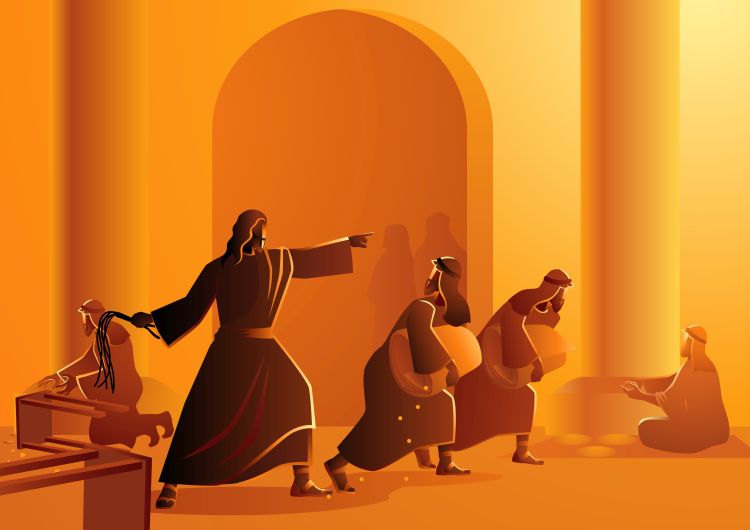
- Healing the blind and lame
- Cursing the fig tree on the way from Bethany to go and teach In the temple – provocatively right under the nose of the religious leaders
- Argument with the Chief Priests and Elders about his authority to heal and telling parables including the one about Vineyard owner sending his sons and getting them killed – and then challenging them “Have you never read in the Scriptures: ‘The stone the builders rejected has become the cornerstone. This is from the Lord, and it is marvelous in our eyes’? and then telling them “that the kingdom of God will be taken away from you and given to a people who will produce its fruit”
- Debate with the Pharisees – should you pay taxes to Caesar? Render unto Caesar what is Caesar’s
- Debate with the Sadduccees about the wife who had seven husbands when they asked who will be her husband in heaven.
- Anointed by a woman with expensive perfume in Simon’s house in Bethany
- Passover meal and betrayal by Judas
- Then the reference to the cups:
- At the meal – this is my blood of the new covenant – which we make real to ourselves in our communion service – but he didn’t drink all the four ceremonial cups of the Jewish Passover at the meal
- In Gethesemane – sweating blood – if this cup cannot pass away, I will drink it
- On the cross – the branch of hyssop with sour wine before – being that final physical cup of of the Passover meal – but also more figuratively the as he makes the final proclamation ‘it is finished’ – his death on the cross is known as the Cup of Consummation.
So was the triumphal entry that Palm Sunday that we remember today a choice – that went very wrong? I don’t think so – I suggest it is an intentional provocation. He entered in a ceremonial way, re-enacting prophesy to iconically show himself as the Son of Man. He then deliberately confronted the seat of power in the temple. He disrupted the corrupt economic system of money changers and provoked the temple authorities which could not go unmet. He saw off the arguments of each group – the Sadducees and Pharisees, forcing them to up the ante and take him out – by arranging his death.
It was the intentional action of Jesus and brought about the climactic resolution of his time on earth. His mission was to reconcile man to God. This is the same Jesus who flung stars into space at the creation event. This is the same Jesus who was born in Bethlehem as a baby and then some decades later, began his years of ministry refusing to accept the temptations in the desert to use his divinity to claim power – which we focused on at the start of Lent. Now as he is concluding his earthly ministry he responds to the challenge by refusing to pay back evil for evil, refusing to strike back those who flog him, curse him, chastise him, mock him with a crown of thorns, even refusing to call on angels to take him down from the cross.
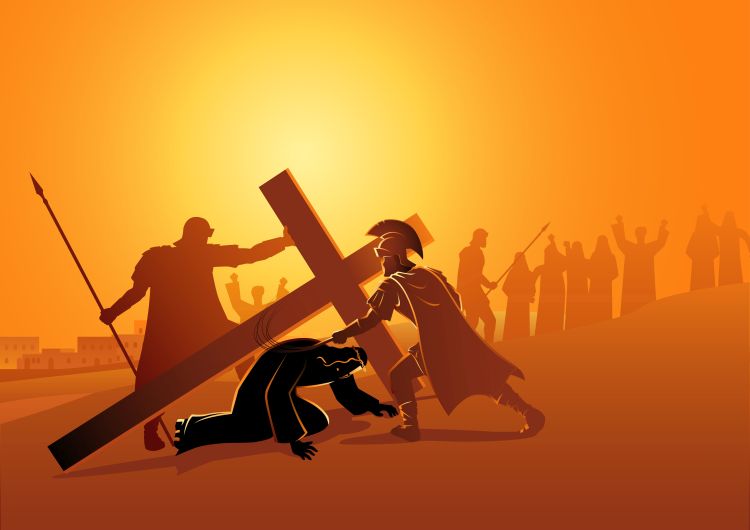
Going further he faces the crucifixion which is surely the ultimate depravity, not just the physical agony and social humiliation – but the gut-wrenching separation from His Father – ‘why have you forsaken me?’ And through this crucifixion event, I see Jesus bringing the pain of human misery and suffering into the Godhead, drawing it into God.
Many have cried out to God why do you allow this human tragedy, where were you in the Holocaust and yet through the Crucifixion we have a God who knows suffering and can relate. God has brought the suffering into himself. He identifies with us in the depth of human misery in the most profound way because he was there with us.
So stepping back to the dusty road and the procession into Jerusalem. We have Jesus – intentionally facing the culmination of his ministry and the fulfilment of his time on earth – deliberately provoking the authorities to a conflict and leading to the most unimaginable horrible and beautiful climax, the ultimate expression of love and a true singularity event of the crucifixion that most fully shows us the nature of God.
And what of us? Are we as intentional as we could be – or should be?
So let us challenge ourselves. What are our intentions with the time given us on earth? Do we live as comfy a life as possible? Or do we set out to do God’s purposes, to be an agent to show God’s love, to serve the purpose of God in our generation? Perhaps if you will, you could take the palm cross from this day and keep it through the year to think on – how am I doing? How intentional am I being? How am I responding to the opportunity I’ve got to be God’s agent? What will I do?
Neil Mackin
Readings for 9 April
Matthew 28: 1-10 (NIV)
Jesus Has Risen
After the Sabbath, at dawn on the first day of the week, Mary Magdalene and the other Mary went to look at the tomb.
2 There was a violent earthquake, for an angel of the Lord came down from heaven and, going to the tomb, rolled back the stone and sat on it. 3 His appearance was like lightning, and his clothes were white as snow. 4 The guards were so afraid of him that they shook and became like dead men.
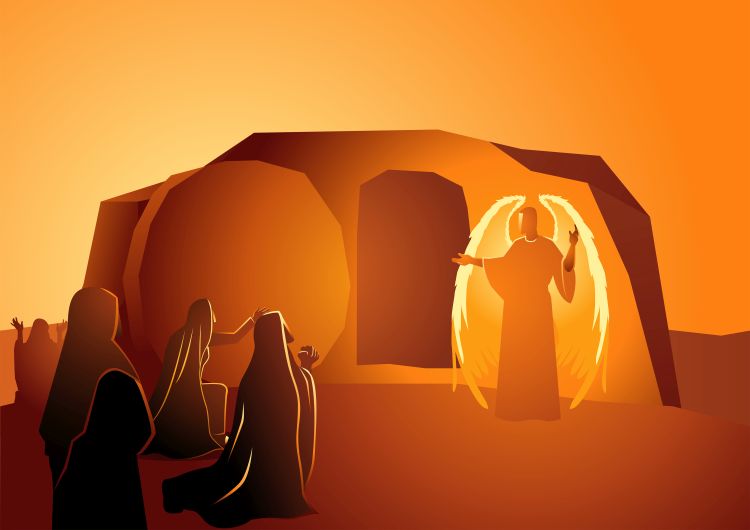
5 The angel said to the women, “Do not be afraid, for I know that you are looking for Jesus, who was crucified. 6 He is not here; he has risen, just as he said. Come and see the place where he lay. 7 Then go quickly and tell his disciples: ‘He has risen from the dead and is going ahead of you into Galilee. There you will see him.’ Now I have told you.”
8 So the women hurried away from the tomb, afraid yet filled with joy, and ran to tell his disciples. 9 Suddenly Jesus met them. “Greetings,” he said. They came to him, clasped his feet and worshiped him. 10 Then Jesus said to them, “Do not be afraid. Go and tell my brothers to go to Galilee; there they will see me.”
Further readings from the lectionary this week are as follows:
- Acts 10: 34-43
- Psalm 118: 1-2, 14-24
- Colossians 3: 1-4
Readings for 16 April
John 20: 19-31 (NIV)
Jesus Appears to His Disciples
19 On the evening of that first day of the week, when the disciples were together, with the doors locked for fear of the Jewish leaders, Jesus came and stood among them and said, “Peace be with you!” 20 After he said this, he showed them his hands and side. The disciples were overjoyed when they saw the Lord.

21 Again Jesus said, “Peace be with you! As the Father has sent me, I am sending you.” 22 And with that he breathed on them and said, “Receive the Holy Spirit. 23 If you forgive anyone’s sins, their sins are forgiven; if you do not forgive them, they are not forgiven.”
Jesus Appears to Thomas
24 Now Thomas (also known as Didymus), one of the Twelve, was not with the disciples when Jesus came. 25 So the other disciples told him, “We have seen the Lord!”
But he said to them, “Unless I see the nail marks in his hands and put my finger where the nails were, and put my hand into his side, I will not believe.”
26 A week later his disciples were in the house again, and Thomas was with them. Though the doors were locked, Jesus came and stood among them and said, “Peace be with you!” 27 Then he said to Thomas, “Put your finger here; see my hands. Reach out your hand and put it into my side. Stop doubting and believe.”
28 Thomas said to him, “My Lord and my God!”
29 Then Jesus told him, “Because you have seen me, you have believed; blessed are those who have not seen and yet have believed.”
The Purpose of John’s Gospel
30 Jesus performed many other signs in the presence of his disciples, which are not recorded in this book. 31 But these are written that you may believe that Jesus is the Messiah, the Son of God, and that by believing you may have life in his name.
Further readings from the lectionary this week are as follows:
- Acts 2: 14a, 22-32
- Psalm 16
- 1 Peter 1: 3-9
Our worship
We meet at 11am for our Sunday services, which are also live-streamed on our Facebook page. If you wish to view our services online, you can find them at www.facebook.com/christchurchuxbridge. You do not have to be a Facebook user to watch them – our services are publicly viewable. You can also view a recent service on our church website. We have two services for Easter Sunday – a 9.30am communion service led by Christ Church members, Joanne Mackin and Louise George, followed by hot cross buns in the meeting area before the 11am service led by Methodist local preacher, Richard Reid. You can find the orders of service here.
If you are unable to join us in person or online for our Sunday services, but would like to receive a recording of them on a memory stick to watch at home, please let us know.
Forthcoming services
6 April – Christ Church worship group – Maundy Thursday, 7pm
9 April – Joanne Mackin & Louise George (Christ Church members) – Easter Sunday communion, 9.30am
9 April – Richard Reid (Methodist local preacher) – Easter Sunday, 11am
16 April – Revd Andrew Pottage (Methodist minister) – Holy Communion
23 April – Christ Church worship group
30 April – Christ Church worship group
Holy Week
Friday 7 April
Good Friday Walk of Witness, 10am
This year’s Good Friday walk of witness will start with a short service at St Andrew’s church, followed by a procession through the town centre towards St Margaret’s church where the walk will conclude with a short Passion play. All are welcome.
Sunday 9 April
Easter Sunday Holy Communion, 9.30am
Our Easter Sunday communion service will be a short service led by Joanne Mackin and Louise George. This will be followed by hot cross buns in the meeting area.
Easter Sunday service, 11am
Our 11am Easter Sunday service will be led by Methodist local preacher, Richard Reid.

Easter thoughts
At Easter it is perhaps right to ask why Jesus of Nazareth was thought to be dangerous. After all Roman and Jewish authorities already knew of him. For as long as he confined himself to a small corner of rural Galilee he could be tolerated. However, but not in Jerusalem! What we know as Palm Sunday was probably unnoticed by most of the Passover pilgrims in the city. So also Jesus’ “cleansing of the Temple”! It was Jesus’ answer when asked if it was right to pay Roman taxes that sealed his fate. Of the coin he asked to see he said they should give back to Caesar what belonged to Caesar but they should give back to God what belonged to God. Both the Romans and the Jewish religious leaders knew he meant the land of Israel. In Roman eyes that was sedition and could not be tolerated. Matthew’s attempt to whitewash Pilate does not conform with what history knows about Pontius Pilate. He had executed many. Why would one more bother him?
The gospels reveal a Jesus who was a preacher, a healer and an exorcist who believed he was living in the end times. The time when God would create His kingdom was near. Perhaps it was an expectant Jesus that entered Jerusalem. Why else did he cry out from his cross “My God, my God, why have you deserted me?”
Howard Cooper
CTU Bible study
CTU Friendly Bible Study series Spring 2023:
Paul’s letter to the Philippians
Weekly – Tuesdays, 1.15pm – 2.15pm at the Quaker Meeting House, York Road, Uxbridge
From 18th April – 6th June
“This is Paul’s happiest letter. And the happiness is infectious. Before we’ve read a dozen lines, we begin to feel the joy ourselves – the dance of words and the exclamations of delight have a way of getting inside us.” (Eugene Peterson, translation of The Message)

You’re invited to an exploration of the language of the text of Phillipians, comparing many translations and sharing what God is speaking to us through this letter, in our personal experiences, following the reflective format of Quaker-inspired Friendly Bible Study. The ideal is to to walk through the text at a leisurely pace over 8 sessions, but you could drop in when you are able and catch up on this short book on your own. Just 1 hour – starts promptly with optional tea after.
Mike Beranek
Children’s Corner
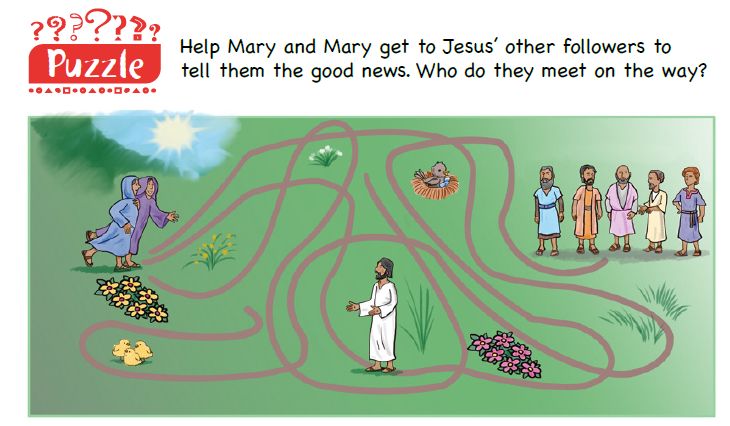
Praying for other churches
w/c 9 April
This week we hold the following churches in our prayers:
- Cannon Lane Methodist
- Acton Hill (URC/Methodist)
w/c 16 April
This week we hold our own church, Christ Church, in our prayers.
Closing prayer
May the risen Christ reign in your hearts;
may the Comforter inspire and challenge you;
may the God of glory be with you, always.
Amen.
(Taken from Roots)
